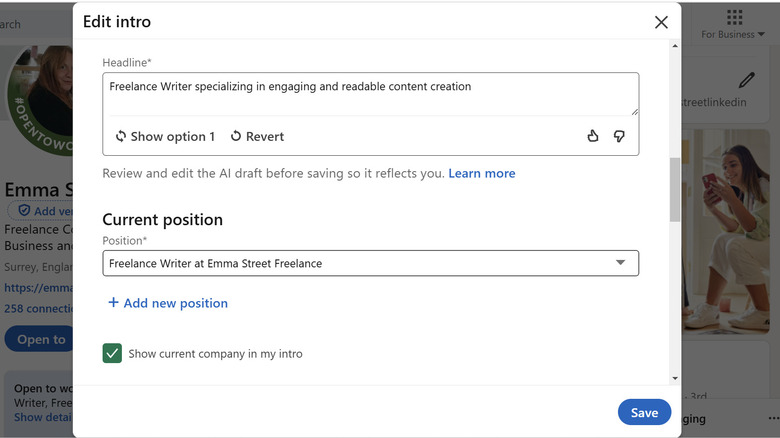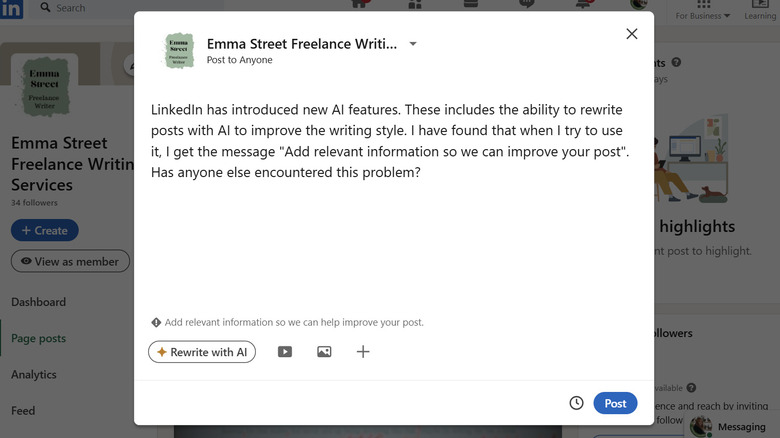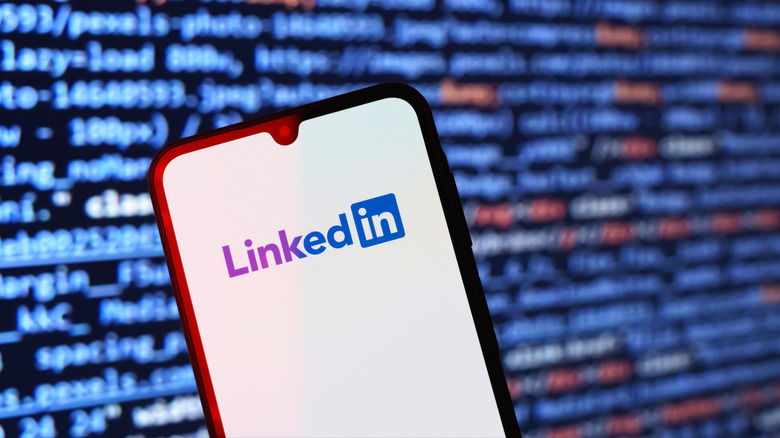LinkedIn Has A Few AI Features For Users To Try (And Here's How To Use Them)
LinkedIn has recently introduced a new AI Hiring Assistant tool, which, according to its website, will "take on a recruiter's most repetitive tasks so they can spend more time on their most impactful work." This is an interesting development for recruiters who are handling applications for dozens of positions and managing hundreds –- if not thousands –- of applicants. However, most users aren't using LinkedIn to do this. You might be using the networking platform to look for work, network, and promote your business. If you're wondering whether there are AI LinkedIn tools to help with these things, too, then the answer is yes.
AI features are only available with Premium Plans, so you'll need to commit to monthly payments, starting from $29.99 per month for the Career plan. There are other plans for businesses, sales managers, and recruiters. If you want to make use of the AI Hiring Assistant tool, for example, you'll need a Recruiter & Jobs account with customized pricing starting at around $835 a month. Currently, you can sign up for a one-month free trial for LinkedIn Career and Business plans, so you can find out for yourself if LinkedIn's AI and other premium features are worth paying out for.
Get suggestions for your LinkedIn headline
One of LinkedIn's AI features is the promise to "Strengthen your headline with AI." Your LinkedIn headline is a 220-character description that appears directly under your name on your LinkedIn profile. It's especially helpful for people running their own businesses or looking for work, as it's a quick way to sell yourself and let people know what your skills are. If you don't enter a headline, it will default to your current job title.
My headline is "Freelance Content Writer | Technology, Business, and Tea," which covers the basics but, honestly, could be better, so I was curious to see what LinkedIn's AI would come up with. It used details from my experience section and provided three alternate headlines. The AI suggestions weren't any better than my current version. Two added "@ self-employed," which seems superfluous for a freelancer. One recommendation was "Freelance Writer specializing in engaging and readable content creation," which was a lot vaguer than the original.
None of the answers did what many LinkedIn gurus recommend: Using your headline as a mini elevator pitch, like "providing tailored writing solutions to the B2B finance industry." It is also interesting to note that the AI-generated text used American English even though my LinkedIn is a UK account that uses British English everywhere else. (If employers are looking for tell-tale signs of AI involvement, American spellings of words like "specialize" will be a giveaway on British, Australian, or Canadian accounts. Although I wasn't impressed with the results I got, I can see that this could be a helpful way to overcome writer's block if you don't know where to start when creating a headline from scratch.
Create or modify your About section and job descriptions
You can use AI to create or modify your profile's 'About' section. The usefulness of the output will wholly depend on the quality of the information you've already provided in your LinkedIn resume, which it will scan to produce an introduction that covers your skills and experience. Be warned that if you're averse to clichés and management-speak, you're going to need to do a lot of rewriting. My AI-generated text included phrases I wouldn't be able to say with a straight face, like, "My mission aligns with the fast-paced evolution of technology" and "My writing encapsulates a deep understanding of the financial technology landscape."
You can also get AI to rewrite your job descriptions in the Experience section. Because it can only use the information already provided, many of the edits suggested for my job descriptions were minimal. However, it does a good job of removing grammatical errors and spelling mistakes. Where this feature works particularly well is fleshing out a basic list of things you did. For example, I wrote "product development. style formats. fix technical issues. online testing. proofreading" in a job description, and the AI rewrite turned it into something readable.
Rewrite LinkedIn posts
When I tested the Rewrite with AI function on LinkedIn, it was incredibly buggy, with only about one out of 10 requests producing anything at all. Unlike ChatGPT, which will try to do its best with whatever you give it, LinkedIn AI needs to have its original text presented in a very specific way. Otherwise, you get the response, "Add relevant information so you can improve your post."
The LinkedIn website provides specific examples, but even when I used barely-tweaked versions of those, it still didn't cooperate most of the time. You must write at least 20 words in the text box to use the feature. However, it doesn't want direct instructions like "Write a post about time management." When I tested it, it didn't correct posts with obvious spelling and grammatical errors, and it also didn't work when I tried to use AI to flesh out a rather dull sales promotion post. I even tried copying and pasting posts from other people on LinkedIn, and every time, I was met with the same "Add relevant information" response and no AI-generated rewrites.
If the issue is that I wasn't writing the posts in a format it could work with, it would make sense that a lot of other people using LinkedIn aren't, either. AI rewrites of draft posts are a feature that LinkedIn is promoting heavily as an enticement to upgrade to Premium. It would be very frustrating for anyone who signed up specifically for this feature to find that it simply doesn't work in the way that's been promised. Either LinkedIn misunderstood how people write posts on its platform, or it was simply uncharacteristically buggy on the days I tested it.
What AI tools are there for business pages?
LinkedIn AI is available on both personal pages and business pages. If you have a LinkedIn business page, you'll need to ensure you're using a Premium option that covers this as well. Business page admins can use AI for everything they can do on a personal page, like rewriting posts and creating an About section. There are also some kinds of content that are exclusive to business pages, such as articles and newsletters, and here, AI options are limited.
If you are putting together an article, you can create an AI-generated headline image within LinkedIn using Microsoft Designer. You need to enter a prompt like "A man sitting at a desk surrounded by clocks and paperwork," just as you would in DALL-E. You can then edit and refine the image. However, when it comes to writing the article, you are on your own. Of course, if you really want to create AI-generated articles, you can simply produce them in ChatGPT and paste them in here. Similarly, the newsletter function doesn't have AI text creation options. LinkedIn is rolling out new AI features regularly, so these may become available in the future.
If you're using LinkedIn to produce advertising campaigns, you can use AI assistance to set up tailored campaigns based on predefined objectives, including brand awareness, engagement, and lead generation.
How does LinkedIn AI help with Job applications?
One of LinkedIn Premium's major selling points is its AI assistance for job seekers. It claims that "Premium members are 39% more likely to hear back after applying for a job on LinkedIn." The AI-powered job assessment provides options for potential jobs like Am I a good fit?, Tailor my resume, and How can I best position myself? These prompts compare the information in your resume with the job specs, let you know where you're a good match, and highlight areas of experience to prioritize in your application. Mostly, this is going to tell you what you already know. Most people remember whether they've got experience managing a team or using Jira. All AI feedback comes with the caveat that the feature "is in beta and may make mistakes."
LinkedIn AI can also write your cover letter for you, and this is where things get interesting. Many people hate writing cover letters, so having one generated for you in seconds is very attractive. The results do sound very AI, though. Some employers would be turned off applications containing statements like "My passion for producing engaging content aligns perfectly with your company's vision," and the AI regurgitated large chunks of the job description verbatim.
The AI does seem to be a pretty good judge of whether or not you've got the right experience and qualifications for a role. I asked it whether I was a good fit for a Senior Dental Nurse position (something I am utterly unqualified for), and it suggested I get some relevant training before applying.
What are the limitations of LinkedIn's AI?
There are still problems with LinkedIn's AI functionality, especially the glitches with the post rewrite feature. It also raises the question of whether the ease of creating content and job applications will result in much more noise without any increase in quality.
For example, using AI meant I could produce a cover letter for the dental nurse role in seconds. I wasn't qualified, but my AI-generated cover letter confidently stated that "my experience in managing software release schedules aligns well with the responsibilities of coordinating dental treatments." I was almost tempted to send it. Of course, encouraging people to send out unsuitable job applications could be part of LinkedIn's strategy. Recruiters will need to sign up for AI HIring Assistant just to deal with the influx of applicants.
There are still plenty of things you can't do with AI on LinkedIn. You can't use AI to reply to posts, compose direct messages, or rewrite event descriptions. It's likely that people are already generating these types of content with ChatGPT, so it's possibly only a matter of time before LinkedIn introduces it.
What does the future hold for AI on LinkedIn?
The main challenge that LinkedIn will need to overcome is making its AI not sound like AI. In many professions, being seen to be using AI will hamper your chances of finding work, attracting followers, and building networks. LinkedIn's AI is a long way from that at the moment. And there's a good chance that your AI-generated cover letter will end up straight in the virtual bin. According to research by CVGenius, 80% of hiring managers dislike AI-generated content on job applications. Many users criticize LinkedIn for being overrun by AI 'slop,' a recent term meaning low-quality AI content. LinkedIn has also been under fire for using members' data to train its AI products.
However, as with any type of artificial intelligence, LinkedIn's AI features' usefulness will depend on how they are used. AI is a valuable tool to generate ideas and overcome writer's block. Job matching tools that use artificial intelligence to assess your suitability for a job, rather than just matching keywords, could take a lot of the grunt work out of looking for work. As many of LinkedIn's AI features are still in the beta stage, it's going to take time before we know whether AI improves the LinkedIn networking experience or if we end up with a site where bots are simply talking to other bots with no human interaction at all.







